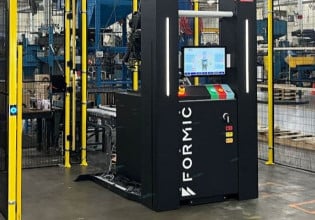Emerson Commercial HVACR Variable Frequency Drives (VFDs) are Designed for Industrial Refrigeration
Meatpacking and medical facilities may find use for this VFD line to help save energy on refrigeration.
Emerson recently released a line of variable frequency drives (VFDs) designed to control cooling and refrigeration equipment. The Copeland HVACR VFDs can control fans and compressors, making them more energy efficient and less noisy.
Copeland HVACR VFD controller. Image used courtesy of Emerson
“With variable frequency drive technology, the end user typically experiences improved temperature and humidity control, reduced noise, and adaptable capacity for changing loads and weather conditions,” said senior product manager, Joe Summers.
About Variable Frequency Drives (VFDs)
As the name implies, VFDs change the frequency of a signal to control the speed of a motor. Instead of having a simple on-off controller, where a motor must be turned off entirely or run at 100% of its speed, a VFD allows the motor to be run efficiently at lower speeds. This is more efficient than simply adding a series resistor to reduce the current to the motor because it only supplies the necessary current to maintain the required speed.
VFDs can save energy by not running at full speed, continuously, but rather adjusting the speed to meet the conditions through either user input or by being placed in a feedback loop with sensors and set points. They also save maintenance costs because the motor adjusts to the proper speed instead of rapidly switching from off to on and off again. Those cycles result in thermal stresses and additional mechanical wear—all of which are avoided with VFDs.
Variable Frequency Drives (VFDs) in Industrial Refrigeration
A VFD in industrial refrigeration and cooling can control the speed of the compressor and fans. During periods of high cooling demand, the VFD can increase the compressor’s speed, but then decrease the speed as demand decreases.
For example, in refrigerated food storage, such as in a meatpacking plant or at the grocery store, the cooling demands may change rapidly. At the grocery store, customers are constantly opening and closing the doors to refrigerated displays. With the VFD, the compressor’s speed can vary based on how often the door is being opened.
An example industrial refrigeration facility.
Besides meatpacking and grocery store applications, industrial refrigeration and cooling is used in the medical industry, powder processing of materials, certain polymers work, and various other industries. All of these can benefit from VFD-controlled cooling over standard on-off controllers.
Emerson’s Copeland Variable Frequency Drives (VFDs)
Emerson offers two product lines of Copeland VFDs. The EVM line can run equipment from ½ horsepower (HP) to 30 HP, and are suitable for medical products, walk-in and reach-in coolers, and other similar equipment. They feature Bluetooth connectivity and are available in single and three-phase power configurations.
The EVH line can run equipment from 1 to 250 HP, suitable for large cooling operations, such as meatpacking plant freezers. The EVH line can use all standard three-phase power configurations, including up to 575 V. It can control additional cooling equipment, such as CO2 booster systems, which are run at a higher pressure than traditional refrigerants.
Any time equipment can be smartly controlled, there is an energy saving. Emerson’s VFDs in the refrigeration market do just that: They adapt to the present load requirements, only running when necessary, and reduce the number of hard starts and stops, reducing maintenance time and expense.






